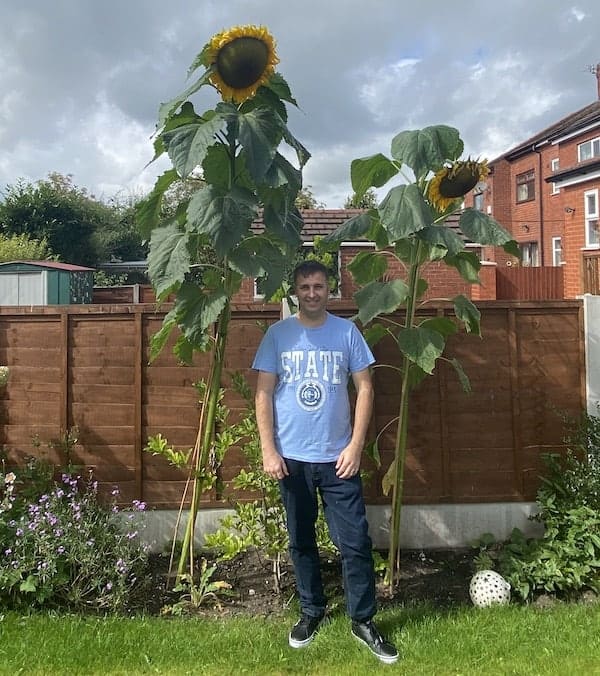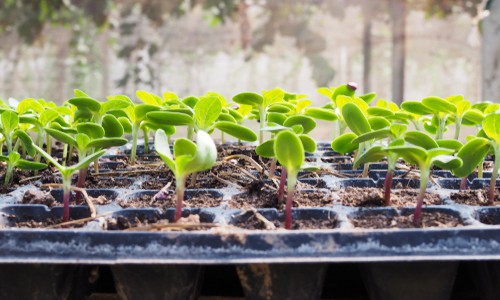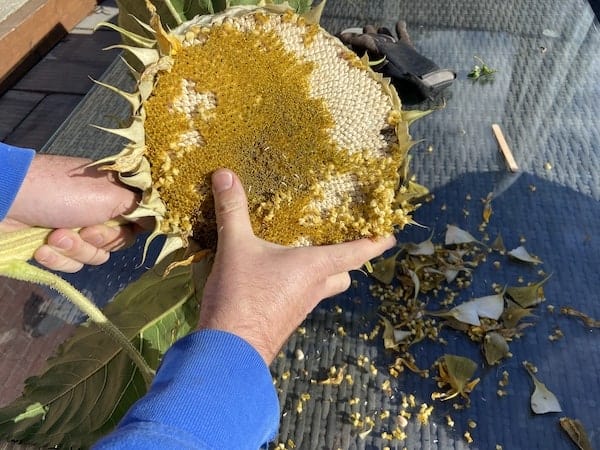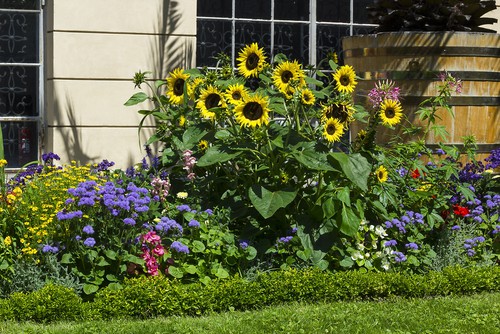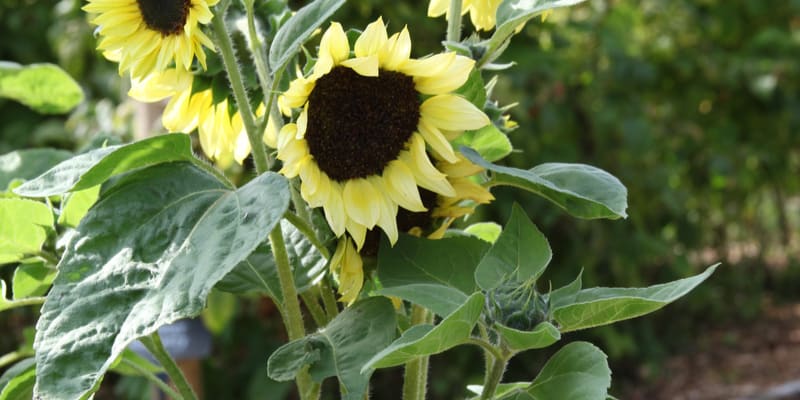
How to Grow Sunflowers – The beginner’s guide
Our site is reader supported, this means we may earn a small commission from Amazon and other affiliates when you buy through links on our site.
We all love sunflowers for their large vibrant yellow flowers and the impressive size of some of the taller varieties. However, did you know they also come in colours like red, bronze and white? There are also lots of varieties that grow to different sizes from smaller varieties that only reach around 30cm to larger mammoth tall varieties that can reach over 300cm (3m).
You can grow these versatile plants yourself and reap the benefits of their beauty and delicious seeds. If you are planning to grow some sunflowers in your garden or plan to pot them for indoor use, there are a couple of things to keep in mind. It’s also worth noting it only takes around 11 to 18 weeks from sowing seeds to flowering so you don’t have to wait long to see your results. The best thing is they are also super easy to grow and a great way for children to get into growing plants.
I have a few tips on cultivating and caring for your sunflowers regardless of the variety. Let’s get started!
Where to plant sunflowers
Sunflowers are easy to grow as long as the conditions are right. With various varieties available, it is safe to say that they are not fussy plants which is why they are so popular. All they need is fertile, well-drained soil and plenty of sun.
Taller varieties and those with very big heads like the ‘American Giant’ also need support to prevent them from drooping, this is often caused by their large heads.
You can learn more about why your sunflowers might droop here
When do you plant sunflowers?
Sunflowers grown from seed (which I personally think is the best way to grow them) should be sown around April/May in small 9cm pots or a similar-sized pot, so even yoghurt pots work! Plant the seeds into a seed compost or multi-purpose compost, keep them watered and place them in a heated greenhouse or sunny windowsill within your home.
If you want your sunflowers to flower at different times you can also sow several lots of sunflowers seeds a week or two apart and this way you can enjoy seeing your sunflowers bloom all through summer at different intervals.
Once they are established with good root systems they can be planted in the garden after the risk of frost has passed in your area. For most areas in the UK, this is usually the end of May to around early June.
Sunflowers you have purchased in pots rather than grown yourself should also not be planted out until the risk of frost has passed, even if you purchased them earlier in the season. Sunflowers are frost tender and the cold weather will certainly kill off young sunflowers.
It’s now getting popular to grow smaller cultivars indoors so you obviously don’t have to worry about frost, but they still need plenty of light. This makes the smaller varieties perfect for growing in windowsills or even conservatories.
How to plant and grow sunflowers
First things first, which variety will you be cultivating? Selecting the variety you want to grow lets you know from the offset what to expect in terms of size. After selecting the variety, it is time for the fun bit, sowing the seeds.
Growing sunflowers from seed
Step 1
Use peat pots, alternatively, you can fill small pots or any small container (just make sure they have holes in) with seed or multi-purpose compost.
Step 2
In each pot, place one seed about 1.5cm deep. If you plant them too shallow you will find that they fall over easily as they begin to grow.
Step 3
Water the pots with a watering can and place them in a propagator with a lid. If you don’t have a propagator, don’t worry, just cover the pots with clear plastic wrap until they germinate. It just helps retain moisture and prevents them from drying out.
Step 4
Place the pots in a cool position where they can access indirect sunlight.
Step 5
When the seeds begin to germinate, remove the plastic wrap or propagator lid (or open the vents) and continue watering to keep the soil moist.
Step 6
It is important to harden the plants first before transplanting them to bigger pots outside or planting them into the ground. For most people, you can plant them outdoors once the risk of frost has passed, which is usually the end of May to the beginning of June.
When the sunflowers are established in their pots and ready to plant out, dig a sizeable hole ensuring to integrate a lot of rotted manure or compost to the hole to feed the young plants as they continue to mature. Make sure you plant them to the same depth as they are in their pots, in other words, don’t plant them any deeper than they are in their pots.
Finally, make sure you have adequate spacing (18-inches) between the sunflowers is vital because you want the plants to have enough space to grow and be well ventilated as this helps to prevent any fungus diseases.
Read next: Why are my sunflowers not flowering
Harvesting sunflower seeds
Sunflower seeds are usually ready to harvest around October time. You will know when they are ready as the back of the flower heads will turn yellow, the petals will be brown and the head will be facing down, almost in a wilting position. At this point, they are well past their glory days.
Simply rub your fingers over the flower head and this removes the tiny blossoms that make up the sunflower head to reveal the hundreds, if not thousands of sunflower seeds. The seeds fall out easily if they are ready to harvest and if not leave them another week or two. If you have an issue with birds and squirrels eating the seeds before they are ready to harvest, you can cut the flower heads off early and place them in a paper bag to dry out indoors for a week or two before harvesting the seeds.
If they’re ready, cut the flower head off and remove the seeds by rubbing your hand against them. They can be eaten but you will need to remove the hard shells. They also make excellent feed for squirrels and to feed the birds over the winter months.
Sunflower care tips
Sunflowers are super easy to grow and you need very little gardens accessories to do it. You can literally use old food pots and some sunflowers from a packet of birdseed to get started. Sunflowers need some care to ensure they mature properly. However, they don’t need round the clock care but here are a few extra tips.
- Feed your sunflowers, especially when the blooms are about to appear. A high potassium feed is recommended and tomato feed is affordable and works well.
- If you are growing the larger varieties, structural support is important to avoid damage to the stem. Stake them but don’t have the ties/string too tight around the stem, leave some room for them to grow or the stems can get choked.
- On especially hot days, ensure the plants get enough water, especially younger plants that are yet to establish intricate root systems. Sunflowers grown in pots need alot of water regularly.
- If you plan on collecting seeds, harvest them only after the petals have started to die off and the head discolours to yellow.
- To deter snails or slugs from attacking your sunflowers, place crushed eggshells or tiny rough stones to obstruct their movement up the plant. If you grow them in containers you can also use a sticky copper wire.
- Avoid damaging sunflower roots when transplanting by using too much force. Be gentle and do not squeeze the root ball. Always hold the leaves when transplanting seedlings. These can be replaced but broken stems can’t.
- Pinch out the growing tip of your sunflower if you want it to produce more flowers rather than grow taller. That being said, don’t do this with varieties that only get one single large flower.
Read next: Why are my sunflower leaves turning yellow
Wrapping up
When in bloom, the sight of sunflowers is amazing, especially when you know you have grown them from seed yourself. Do yourself a favour and grow them in your garden, you will not regret it.
